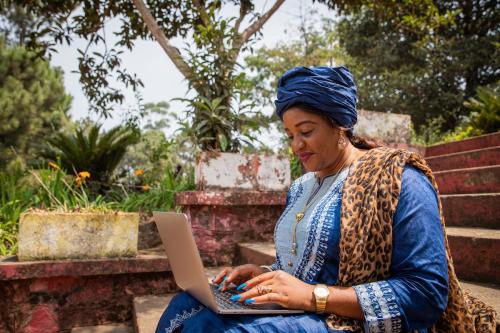From artificial intelligence for medical diagnostics to mobile technology for data collection and contact tracing, technologies associated with the Fourth Industrial Revolution offer efficient and effective ways to cope with the speed, scope, and impact of the COVID-19 pandemic. But these technologies are far from evenly distributed around the world, and this leaves lagging countries and their vulnerable populations at a considerable disadvantage in their capacity to decrease the risk and slow the transmission of the disease.
These technologies are already showing promise in helping contain and cope with the pandemic. AI and mobile technology offer data collection tools to aid in contact tracing, symptom checking, and predicting outbreaks and vulnerabilities. Partners HealthCare, for example, created an AI-based COVID-19 screener to identify patients suffering severe symptoms of the disease, and the Canadian AI model BlueDot provided an early warning on Dec. 31, 2019 that the novel coronavirus would spread globally. AI-based computer vision cameras are being used to assess whether social distancing is being respected in public areas, and AI-based thermal imaging cameras have been used, worryingly, to scan public spaces and identify potentially sick people in China. Apple and Google have partnered to adapt mobile Bluetooth technology to contact tracing. Cloud-based platforms make it easier for workers and students to practice social distancing, as do drones and robots by delivering medical supplies to health facilities and medicine and meals to infected patients. Mobile money allows vendors to go cashless.
Advanced materials and nanotechnologies are also playing a critical role in rapid diagnostics, therapeutics, surveillance and monitoring, vaccines, and developing new forms of personal protective equipment. Nanotech Surface, an Italian company, has developed a nanomaterial-based sanitizer that continues to kill bacteria for months after being applied to a surface, and the Czech Respilon Group is designing nanofiber respiratory masks capable of killing a virus rather than just trapping it, protecting the wearer as well as his or her surroundings. 3D printing enthusiasts are stepping in to make crucially needed medical supplies.
But not all countries have the same ability to harness these technologies to fight COVID-19. Countries around the globe vary in capacity, which refers to the physical and digital infrastructure and human capital for utilizing these technologies. They also vary in how widely and effectively these technologies are deployed, which we refer to as the usage/effectiveness of Fourth Industrial Revolution technologies.
We can distinguish four categories of countries: countries with high levels of both capacity and usage/effectiveness; those with high capacity but low usage/effectiveness, those with low capacity and high usage/effectiveness, and those with both low capacity and low usage/effectiveness. This framework can help policymakers, innovators, and technologists consider what technological interventions might be most effective in combating COVID-19 based on a country’s existing resources and readiness levels.
High capacity, high usage/effectiveness. Countries with both high capacity and usage/effectiveness have harnessed Fourth Industrial Revolution technology to more effectively combat the outbreak. Germany has managed to keep its COVID-19 death rate much lower than other European countries and is using location data from smartphones to do aggressive contact tracing. A South Korean company utilized its existing AI technology to design testing kits in days rather than weeks, allowing it to scale up production before the crisis hit. The Korea Centers for Disease Control and Prevention (KCDC) uses a mobile app for symptom reporting as well as AI-enabled chatbots and phone calls to disseminate information and identify nearby testing locations. South Korea’s success in using these technologies stemmed in part from its regulatory environment. The Ministry of Health has the authority to collect data from telecom companies, credit card transactions, GPS systems, and other sources, and officials are automatically alerted if someone crosses the boundaries of their mandatory quarantine.
High capacity, low usage. In countries with high capacity but low usage/effectiveness, health care systems are struggling to integrate the technology that could be used to improve their response. In the United States, health authorities have failed to step up the production of necessary medical supplies, and the public health response has been generally haphazard and uncoordinated. Unlike in other technologically advanced countries, the government failed to carry out effective digital contact-tracing operations. Spain has also been criticized for failing to act early on. Their 3-D printing community stepped forward after learning of severe shortages of medical protective equipment, exposing a missed opportunity the government had to mobilize a highly efficient network in stockpiling supplies before the crisis escalated.
Low capacity, high usage. In countries with low capacity but high usage, such as many developing countries in Africa where mobile phone solutions are becoming increasingly popular, technology can be used to aid in promoting social distancing. Increased access and fee reductions in Senegal, Kenya, Uganda, Tanzania, Ghana, and Nigeria are enabling more people to use mobile money in lieu of cash transactions. Ugandan produce vendors, for example, have moved operations to an app called Market Garden, reducing physical human interaction to the motorcycle delivery driver. Nigeria’s health ministry is using WhatsApp push notifications to disseminate accurate information about symptoms, prevention, and treatment. While telehealth is far from a complete solution, it can reduce unnecessary or arduous trips to health facilities. A public-private partnership in South Africa, for example, has made the mobile health platform HelloDoctor free to all during the lockdown.
Low capacity, low usage. Lastly, countries with both low capacity and low usage will be the most vulnerable in the event of a major outbreak of COVID-19. This includes the Central African Republic and Chad, where governments with low capacity will have to think hard about how to best deploy limited resources toward technological innovation in their pandemic response. Some technologies do not require high capacity for effective use, but require instead effective governments to enable them. It is not out of the question, for example, that poor countries with low levels of technological adoption might use drones to deliver medical supplies in the event of a severe outbreak.
In conclusion, technological capacity and usage do not exist in a vacuum: Regulatory environments, privacy concerns, and leadership all impact how 4IR technologies are deployed to meet this global challenge. These technologies are making it possible for many to continue working during lockdowns and are improving the medical response. But the gap between the haves and the have-nots remains massive, both within and between countries. Leveraging the Fourth Industrial Revolution to fight COVID-19 so that no country and no one is left behind will require a combination of investment, innovation, preparedness, and effective use and leadership within countries, but also global cooperation and solidarity among nations to ensure broader access, usage, quality, and effectiveness of the disruptive technologies for a healthier and more prosperous world. The world needs it, and humanity can afford it.
Prof. Landry Signé is a senior fellow at the Brookings Institution, distinguished fellow at Stanford University, and the co-director of the Fourth Industrial Revolution and Globalization 4.0 Initiative at the Thunderbird Global School of Management.
Dr. Sanjeev Khagram is the director general and dean of the Thunderbird School of Global Management.
Julia Goldstein is a graduate fellow at the Fourth Industrial Revolution and Globalization 4.0 Initiative at the Thunderbird School of Global Management.
Apple and Google provide financial support to the Brookings Institution, a nonprofit organization devoted to rigorous, independent, in-depth public policy research.





Commentary
Using the Fourth Industrial Revolution to fight COVID-19 around the world
April 28, 2020